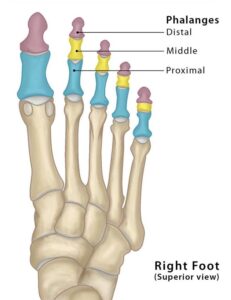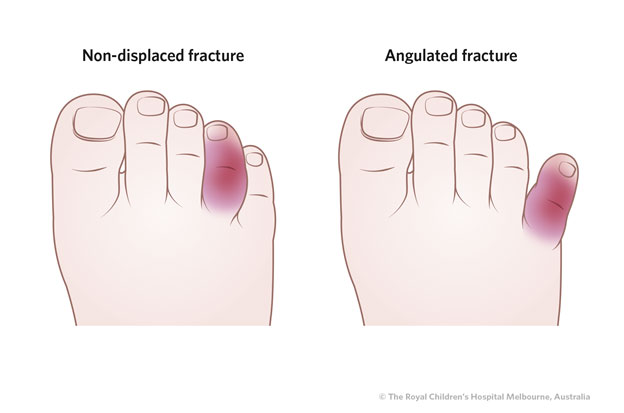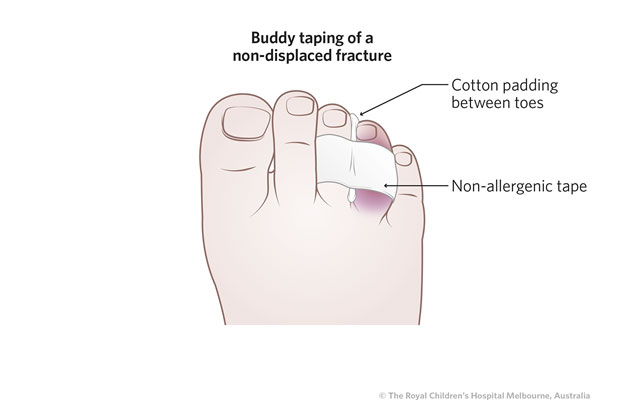Have you ever been told there is nothing you can really do for a broken toe? This is a deep seated belief that many people have for a number of reasons. We’re here to dispel this myth and show that there are many things you can and should do if you suspect you may have a broken toe.
Broken toes are injuries we see all the time in clinic. They can be very painful and limit us from exercising and performing activities of daily living. They usually arise as a result of acute trauma to the toe usually when we stub it, drop something heavy on it or fall on the toe.
If you have injured a toe is is very important to have it clinically assessed. Depending on which toe is involved and the mechanism of injury, different types of fractures can occur. When we do injure our toe through trauma the proximal phalanx is usually the bone which will most likely fracture as it is the longest out of three bones the make up our lesser toes. It is important to note here that the big toe is only made out of 2 bones for reference.

Fractures in the toes are considered to be displaced or non-displaced fractures. Displaced fractures occur when there is a break in the bone and this causes a movement in the alignment of the bone. An undisplaced fracture is where there is a break in the bone but no disruption to the alignment of the bone. A spiral fracture can also occur to the bone whereby a twisting motion occurs which leads to a fracture that spirals around the shaft of the bone. These types of fracture are usually displaced and occur from hyperextension or flexion of the digit. It is important to note that these types of fractures may take longer to heal.
Upon assessment for a potential broken toe there will likely be;
- Self reported throbbing pain.
- Bruising and swelling.
- Localised pain at the fracture site.
- Pain with extension and flexion of the toe.
- Pain with weight bearing.
- Possibility for presence of deformity depending on the nature of the injury.

Majority of fractures to the toe can be managed conservatively. In clinic we have a number of different options we can use to help manage your injury to help with offloading the painful area to allow the bone to heal as quickly as possible. Some of these options may include:
- Footwear changes – we recommend a stiff soled shoe which doesn’t bend at the toes. This reduces the amount of movement that can occur and therefore reduces the toe load that the toe is subjected to. A wide fitting shoe is also recommended toe reduce pressure on the toe.
- Carbon spring plates – this a thin and solid device that can be fitted into a shoe. The carbon plate will prevent flexion/extension of the toe and reduce load on the bone.
- Buddy taping – taping the injured toe to the adjacent toe next to it can help to relieve pain and act as a splint for the toe. This is recommended until pain in the toe has subsided and may be required for up to 6 weeks.

- Pain management – rest, ice and elevation can help to reduce symptoms. K-laser is an adjunct therapy that can also help to reduce pain and inflammation along with stimulating the bodies healing process.
- Padding – padding can be made out of different materials in clinic such as felt, poron or EVA. These pads can be used on the sockliners or innersoles of your shoes to help offload the area to help reduce symptoms and promote faster healing.
- Darco (post op shoes) – we can fit up a post op shoe in clinic. These shoes have a stiff sole and can offload the injured toe. These shoes are a great option for people who need to be on their feet for extended periods of time while at work.
- CAM walker – a moon boot may be needed to offload the toe for a period of time to allow bone healing to occur. These are more likely to be used when managing a fracture to the big toe.
- X-ray referral – an X-ray may be ordered by your podiatrist if they suspect a fracture. This can help to confirm which bone and what type of fracture is present and can be used to check healing.
- Specialist referral – this may be required in the case of children who present with a fracture to the 1st toe. If the fracture has occurred through the growth plate this may require a surgical opinion. In the case where there is a dislocation present you may be referred to emergency department as the digit will be required to be set back in place.
If you suspect you may have a fracture it is best to get the toe assessed clinically by a podiatrist. We can help to diagnose this injury and implement a management plan to help reduce pain and improve healing outcomes so that you can get on with life.
